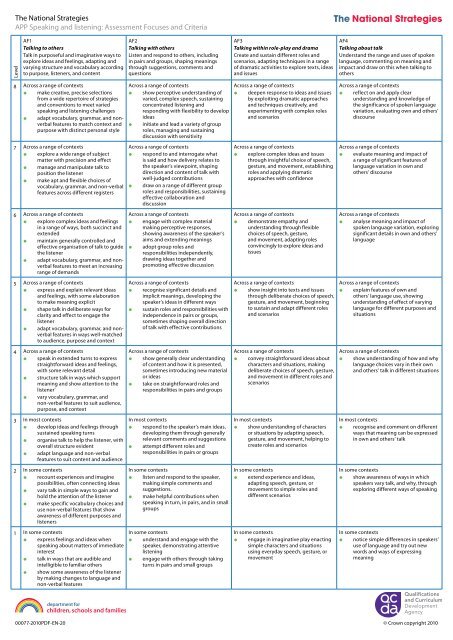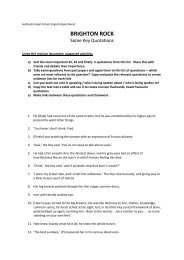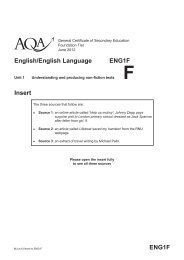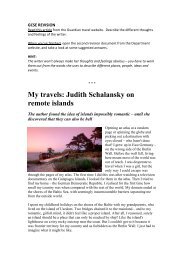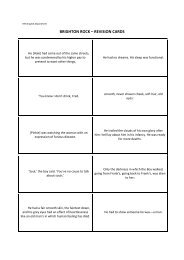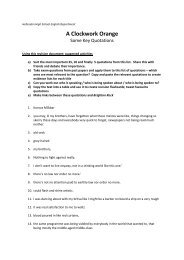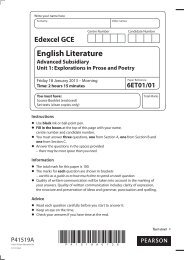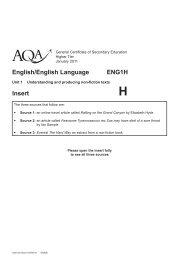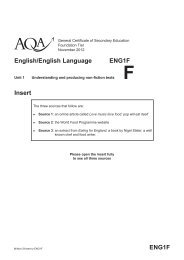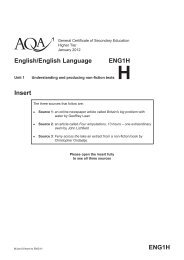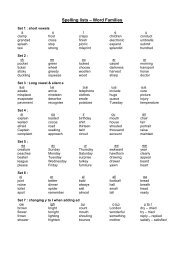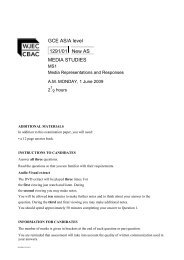APP Speaking and listening: Assessment Focuses and Criteria
APP Speaking and listening: Assessment Focuses and Criteria
APP Speaking and listening: Assessment Focuses and Criteria
You also want an ePaper? Increase the reach of your titles
YUMPU automatically turns print PDFs into web optimized ePapers that Google loves.
The National Strategies<br />
<strong>APP</strong> <strong>Speaking</strong> <strong>and</strong> <strong>listening</strong>: <strong>Assessment</strong> <strong>Focuses</strong> <strong>and</strong> <strong>Criteria</strong><br />
Level<br />
AF1<br />
Talking to others<br />
Talk in purposeful <strong>and</strong> imaginative ways to<br />
explore ideas <strong>and</strong> feelings, adapting <strong>and</strong><br />
varying structure <strong>and</strong> vocabulary according<br />
to purpose, listeners, <strong>and</strong> content<br />
AF2<br />
Talking with others<br />
Listen <strong>and</strong> respond to others, including<br />
in pairs <strong>and</strong> groups, shaping meanings<br />
through suggestions, comments <strong>and</strong><br />
questions<br />
AF3<br />
Talking within role-play <strong>and</strong> drama<br />
Create <strong>and</strong> sustain different roles <strong>and</strong><br />
scenarios, adapting techniques in a range<br />
of dramatic activities to explore texts, ideas<br />
<strong>and</strong> issues<br />
AF4<br />
Talking about talk<br />
Underst<strong>and</strong> the range <strong>and</strong> uses of spoken<br />
language, commenting on meaning <strong>and</strong><br />
impact <strong>and</strong> draw on this when talking to<br />
others<br />
8 Across a range of contexts<br />
• make creative, precise selections<br />
from a wide repertoire of strategies<br />
<strong>and</strong> conventions to meet varied<br />
speaking <strong>and</strong> <strong>listening</strong> challenges<br />
• adapt vocabulary, grammar, <strong>and</strong> nonverbal<br />
features to match context <strong>and</strong><br />
purpose with distinct personal style<br />
7 Across a range of contexts<br />
• explore a wide range of subject<br />
matter with precision <strong>and</strong> effect<br />
• manage <strong>and</strong> manipulate talk to<br />
position the listener<br />
• make apt <strong>and</strong> flexible choices of<br />
vocabulary, grammar, <strong>and</strong> non-verbal<br />
features across different registers<br />
6 Across a range of contexts<br />
• explore complex ideas <strong>and</strong> feelings<br />
in a range of ways, both succinct <strong>and</strong><br />
extended<br />
• maintain generally controlled <strong>and</strong><br />
effective organisation of talk to guide<br />
the listener<br />
• adapt vocabulary, grammar, <strong>and</strong> nonverbal<br />
features to meet an increasing<br />
range of dem<strong>and</strong>s<br />
5 Across a range of contexts<br />
• express <strong>and</strong> explain relevant ideas<br />
<strong>and</strong> feelings, with some elaboration<br />
to make meaning explicit<br />
• shape talk in deliberate ways for<br />
clarity <strong>and</strong> effect to engage the<br />
listener<br />
• adapt vocabulary, grammar, <strong>and</strong> nonverbal<br />
features in ways well-matched<br />
to audience, purpose <strong>and</strong> context<br />
4 Across a range of contexts<br />
• speak in extended turns to express<br />
straightforward ideas <strong>and</strong> feelings,<br />
with some relevant detail<br />
• structure talk in ways which support<br />
meaning <strong>and</strong> show attention to the<br />
listener’<br />
• vary vocabulary, grammar, <strong>and</strong><br />
non-verbal features to suit audience,<br />
purpose, <strong>and</strong> context<br />
3 In most contexts<br />
• develop ideas <strong>and</strong> feelings through<br />
sustained speaking turns<br />
• organise talk to help the listener, with<br />
overall structure evident<br />
• adapt language <strong>and</strong> non-verbal<br />
features to suit content <strong>and</strong> audience<br />
2 In some contexts<br />
• recount experiences <strong>and</strong> imagine<br />
possibilities, often connecting ideas<br />
• vary talk in simple ways to gain <strong>and</strong><br />
hold the attention of the listener<br />
• make specific vocabulary choices <strong>and</strong><br />
use non-verbal features that show<br />
awareness of different purposes <strong>and</strong><br />
listeners<br />
1 In some contexts<br />
• express feelings <strong>and</strong> ideas when<br />
speaking about matters of immediate<br />
interest<br />
• talk in ways that are audible <strong>and</strong><br />
intelligible to familiar others<br />
• show some awareness of the listener<br />
by making changes to language <strong>and</strong><br />
non-verbal features<br />
Across a range of contexts<br />
• show perceptive underst<strong>and</strong>ing of<br />
varied, complex speech, sustaining<br />
concentrated <strong>listening</strong> <strong>and</strong><br />
responding with flexibility to develop<br />
ideas<br />
• initiate <strong>and</strong> lead a variety of group<br />
roles, managing <strong>and</strong> sustaining<br />
discussion with sensitivity<br />
Across a range of contexts<br />
• respond to <strong>and</strong> interrogate what<br />
is said <strong>and</strong> how delivery relates to<br />
the speaker’s viewpoint, shaping<br />
direction <strong>and</strong> content of talk with<br />
well-judged contributions<br />
• draw on a range of different group<br />
roles <strong>and</strong> responsibilities, sustaining<br />
effective collaboration <strong>and</strong><br />
discussion<br />
Across a range of contexts<br />
• engage with complex material<br />
making perceptive responses,<br />
showing awareness of the speaker’s<br />
aims <strong>and</strong> extending meanings<br />
• adopt group roles <strong>and</strong><br />
responsibilities independently,<br />
drawing ideas together <strong>and</strong><br />
promoting effective discussion<br />
Across a range of contexts<br />
• recognise significant details <strong>and</strong><br />
implicit meanings, developing the<br />
speaker’s ideas in different ways<br />
• sustain roles <strong>and</strong> responsibilities with<br />
independence in pairs or groups,<br />
sometimes shaping overall direction<br />
of talk with effective contributions<br />
Across a range of contexts<br />
• show generally clear underst<strong>and</strong>ing<br />
of content <strong>and</strong> how it is presented,<br />
sometimes introducing new material<br />
or ideas<br />
• take on straightforward roles <strong>and</strong><br />
responsibilities in pairs <strong>and</strong> groups<br />
In most contexts<br />
• respond to the speaker’s main ideas,<br />
developing them through generally<br />
relevant comments <strong>and</strong> suggestions<br />
• attempt different roles <strong>and</strong><br />
responsibilities in pairs or groups<br />
In some contexts<br />
• listen <strong>and</strong> respond to the speaker,<br />
making simple comments <strong>and</strong><br />
suggestions.<br />
• make helpful contributions when<br />
speaking in turn, in pairs, <strong>and</strong> in small<br />
groups<br />
In some contexts<br />
• underst<strong>and</strong> <strong>and</strong> engage with the<br />
speaker, demonstrating attentive<br />
<strong>listening</strong><br />
• engage with others through taking<br />
turns in pairs <strong>and</strong> small groups<br />
Across a range of contexts<br />
• deepen response to ideas <strong>and</strong> issues<br />
by exploiting dramatic approaches<br />
<strong>and</strong> techniques creatively, <strong>and</strong><br />
experimenting with complex roles<br />
<strong>and</strong> scenarios<br />
Across a range of contexts<br />
• explore complex ideas <strong>and</strong> issues<br />
through insightful choice of speech,<br />
gesture, <strong>and</strong> movement, establishing<br />
roles <strong>and</strong> applying dramatic<br />
approaches with confidence<br />
Across a range of contexts<br />
• demonstrate empathy <strong>and</strong><br />
underst<strong>and</strong>ing through flexible<br />
choices of speech, gesture,<br />
<strong>and</strong> movement, adapting roles<br />
convincingly to explore ideas <strong>and</strong><br />
issues<br />
Across a range of contexts<br />
• show insight into texts <strong>and</strong> issues<br />
through deliberate choices of speech,<br />
gesture, <strong>and</strong> movement, beginning<br />
to sustain <strong>and</strong> adapt different roles<br />
<strong>and</strong> scenarios<br />
Across a range of contexts<br />
• convey straightforward ideas about<br />
characters <strong>and</strong> situations, making<br />
deliberate choices of speech, gesture,<br />
<strong>and</strong> movement in different roles <strong>and</strong><br />
scenarios<br />
In most contexts<br />
• show underst<strong>and</strong>ing of characters<br />
or situations by adapting speech,<br />
gesture, <strong>and</strong> movement, helping to<br />
create roles <strong>and</strong> scenarios<br />
In some contexts<br />
• extend experience <strong>and</strong> ideas,<br />
adapting speech, gesture, or<br />
movement to simple roles <strong>and</strong><br />
different scenarios<br />
In some contexts<br />
• engage in imaginative play enacting<br />
simple characters <strong>and</strong> situations<br />
using everyday speech, gesture, or<br />
movement<br />
Across a range of contexts<br />
• reflect on <strong>and</strong> apply clear<br />
underst<strong>and</strong>ing <strong>and</strong> knowledge of<br />
the significance of spoken language<br />
variation, evaluating own <strong>and</strong> others’<br />
discourse<br />
Across a range of contexts<br />
• evaluate meaning <strong>and</strong> impact of<br />
a range of significant features of<br />
language variation in own <strong>and</strong><br />
others’ discourse<br />
Across a range of contexts<br />
• analyse meaning <strong>and</strong> impact of<br />
spoken language variation, exploring<br />
significant details in own <strong>and</strong> others’<br />
language<br />
Across a range of contexts<br />
• explain features of own <strong>and</strong><br />
others’ language use, showing<br />
underst<strong>and</strong>ing of effect of varying<br />
language for different purposes <strong>and</strong><br />
situations<br />
Across a range of contexts<br />
• show underst<strong>and</strong>ing of how <strong>and</strong> why<br />
language choices vary in their own<br />
<strong>and</strong> others’ talk in different situations<br />
In most contexts<br />
• recognise <strong>and</strong> comment on different<br />
ways that meaning can be expressed<br />
in own <strong>and</strong> others’ talk<br />
In some contexts<br />
• show awareness of ways in which<br />
speakers vary talk, <strong>and</strong> why, through<br />
exploring different ways of speaking<br />
In some contexts<br />
• notice simple differences in speakers’<br />
use of language <strong>and</strong> try out new<br />
words <strong>and</strong> ways of expressing<br />
meaning<br />
00077-2010PDF-EN-20 © Crown copyright 2010
The National Strategies<br />
<strong>APP</strong> Reading: <strong>Assessment</strong> <strong>Focuses</strong> <strong>and</strong> <strong>Criteria</strong><br />
AF1 – use a range of strategies,<br />
including accurate decoding of<br />
text, to read for meaning<br />
AF2 – underst<strong>and</strong>, describe, select or retrieve<br />
information, events or ideas from texts <strong>and</strong> use<br />
quotation <strong>and</strong> reference to text<br />
AF3 – deduce, infer or interpret information,<br />
events or ideas from texts<br />
AF4 – identify <strong>and</strong> comment on the structure <strong>and</strong><br />
organisation of texts, including grammatical <strong>and</strong><br />
presentational features at text level<br />
AF5 – explain <strong>and</strong> comment on writers’ use of<br />
language, including grammatical <strong>and</strong> literary<br />
features at word <strong>and</strong> sentence level<br />
AF6 – identify <strong>and</strong> comment on writers’ purposes <strong>and</strong> viewpoints,<br />
<strong>and</strong> the overall effect of the text on the reader<br />
AF7 – relate texts to their social, cultural <strong>and</strong><br />
historical traditions<br />
Level<br />
8<br />
Level<br />
7<br />
Level<br />
6<br />
Level<br />
5<br />
Level<br />
4<br />
Level<br />
3<br />
Level<br />
2<br />
Level<br />
1<br />
In most reading<br />
• y range of strategies used mostly<br />
effectively to read with fluency,<br />
underst<strong>and</strong>ing <strong>and</strong> expression<br />
In some reading<br />
• y range of key words read on sight<br />
• y unfamiliar words decoded using<br />
appropriate strategies, e.g.<br />
blending sounds<br />
• y some fluency <strong>and</strong> expression,<br />
e.g. taking account of<br />
punctuation, speech marks<br />
In some reading, usually with<br />
support:<br />
• y some high frequency <strong>and</strong><br />
familiar words read fluently <strong>and</strong><br />
automatically<br />
• y decode familiar <strong>and</strong> some<br />
unfamiliar words using blending<br />
as the prime approach<br />
• y some awareness of punctuation<br />
marks, e.g. pausing at full stops<br />
Across a range of reading<br />
• y clear critical stance develops a coherent interpretation of text(s), drawing on imaginative insights <strong>and</strong><br />
well supported by reference <strong>and</strong> wider textual knowledge<br />
Across a range of reading<br />
Across a range of reading<br />
• y increasing precision in selection <strong>and</strong> application • y comments begin to develop an interpretation<br />
of textual reference to the point being made, e.g. of the text(s), making connections between<br />
close reference at word level to refute an argument insights, teasing out meanings or weighing up<br />
in a short stretch of text, or, deft selection across a evidence, e.g. considering the relative importance<br />
longer textual stretch to evaluate a writer’s<br />
of different pieces of evidence when evaluating a<br />
viewpoint<br />
character’s actions; rejecting an argument after<br />
• y increasing ability to draw on knowledge of other exploring what is left unsaid by its proponent;<br />
sources to develop or clinch an argument, e.g. developing a critique of a writer’s viewpoint by<br />
referring to sources beyond the text to compare the adducing evidence from a range of insights<br />
effectiveness of imagery used<br />
Across a range of reading<br />
• y relevant points clearly identified, including<br />
summary <strong>and</strong> synthesis of information from<br />
different sources or different places in the same<br />
text<br />
• y commentary incorporates apt textual reference<br />
<strong>and</strong> quotation to support main ideas or<br />
argument<br />
Across a range of reading<br />
• y comments securely based in textual evidence<br />
<strong>and</strong> identify different layers of meaning, with<br />
some attempt at detailed exploration of them,<br />
e.g. explaining the association of different words<br />
in an image, or exploring connotations in a<br />
political speech or advertisement<br />
• y comments consider wider implications or<br />
significance of information, events or ideas in<br />
the text, e.g. tracing how details contribute to<br />
overall meaning<br />
Across a range of reading<br />
Across a range of reading<br />
• y most relevant points clearly identified, including • y comments develop explanation of inferred<br />
those selected from different places in the text meanings drawing on evidence across the text,<br />
• y comments generally supported by relevant<br />
e.g. ‘you know her dad was lying because earlier<br />
textual reference or quotation, even when<br />
she saw him take the letter’<br />
points made are not always accurate<br />
• y comments make inferences <strong>and</strong> deductions<br />
based on textual evidence, e.g. in drawing<br />
conclusions about a character’s feelings on the<br />
basis of their speech <strong>and</strong> actions<br />
Across a range of reading<br />
Across a range of reading<br />
• y some relevant points identified<br />
• y comments make inferences based on evidence<br />
• y comments supported by some generally<br />
from different points in the text, e.g. interpreting<br />
relevant textual reference or quotation, e.g.<br />
a character’s motive from their actions at different<br />
reference is made to appropriate section of text but points<br />
is unselective <strong>and</strong> lacks focus<br />
• y inferences often correct, but comments are not<br />
always rooted securely in the text or repeat<br />
narrative or content<br />
In most reading<br />
• y simple, most obvious points identified though<br />
there may also be some misunderst<strong>and</strong>ing, e.g.<br />
about information from different places in the text<br />
• y some comments include quotations from or<br />
references to text, but not always relevant, e.g.<br />
often retelling or paraphrasing sections of the text<br />
rather than using it to support comment<br />
In some reading<br />
• y some specific, straightforward information<br />
recalled, e.g. names of characters, main<br />
ingredients<br />
• y generally clear idea of where to look for<br />
information, e.g. about characters, topics<br />
In some reading, usually with support:<br />
• y some simple points from familiar texts recalled<br />
• y some pages/sections of interest located, e.g.<br />
favourite characters/events/information/pictures<br />
In most reading<br />
• y straightforward inference based on a single<br />
point of reference in the text, e.g. ‘he was upset<br />
because it says “he was crying”’<br />
• y responses to text show meaning established at<br />
a literal level e.g. ‘walking good’ means ‘walking<br />
carefully’ or based on personal speculation e.g. a<br />
response based on what they personally would be<br />
feeling rather than feelings of character in the text<br />
In some reading<br />
• y simple, plausible inference about events <strong>and</strong><br />
information, using evidence from text e.g. how a<br />
character is feeling, what makes a plant grow<br />
• y comments based on textual cues, sometimes<br />
misunderstood<br />
In some reading, usually with support:<br />
• y reasonable inference at a basic level, e.g.<br />
identifying who is speaking in a story<br />
• y comments/questions about meaning of parts of<br />
text, e.g. details of illustrations diagrams, changes<br />
in font style<br />
Across a range of reading<br />
• y clear appreciation <strong>and</strong> underst<strong>and</strong>ing of how the text structure <strong>and</strong> language use support the writer’s<br />
purpose <strong>and</strong> contribute to meaning<br />
Across a range of reading<br />
• y some evaluation of the extent to which structural<br />
choices support the writer’s theme or purpose,<br />
e.g. exploration of the way a play’s plot <strong>and</strong> subplot<br />
reflect on theme, or analysis of how the use of some<br />
inappropriate examples undermine the writer’s<br />
argument against vivisection<br />
• y some appreciation of the skill with which a range<br />
of features relating to organisation at text level<br />
are used, e.g. evaluating or comparing the<br />
effectiveness of timeswitches, section/chapter<br />
breaks or verse forms or use of direct speech in non<br />
narrative<br />
Across a range of reading<br />
• y response to overall effect of the text shows clear underst<strong>and</strong>ing <strong>and</strong><br />
critical evaluation of writer’s purposes <strong>and</strong> viewpoints <strong>and</strong> how<br />
these are articulated throughout the text<br />
Across a range of reading<br />
Across a range of reading<br />
• y comments begin to develop precise, perceptive • y responses begin to develop some analytic or evaluative comment<br />
analysis of how language is used, e.g. showing on writer’s purpose, e.g. showing how the absence of females in Lord of<br />
how language use reflects Macbeth’s changing the Flies affects author’s purpose<br />
emotional state or explaining how euphemisms • y responses begin to develop some analytic or evaluative comment<br />
conceal brutality in a political statement<br />
on how viewpoint is established or managed across a text, e.g.<br />
• y some appreciation of how the writer’s language tracing how a persona is established in a weekly newspaper column or<br />
choices contribute to the overall effect on the dramatic monologue, or how a novelist establishes a first person<br />
reader, e.g. demonstrating the greater<br />
narrator<br />
effectiveness of imagery in poem A than poem B, • y responses begin to develop an appreciation of how particular<br />
or arguing that the use of highly emotive language techniques <strong>and</strong> devices achieve the effects they do, e.g. how the<br />
in a campaign leaflet is/is not counterproductive dramatic monologues serve to retain sympathy for Macbeth despite<br />
in audience effect<br />
what he has done<br />
Across a range of reading<br />
• y some detailed exploration of how structural<br />
choices support the writer’s theme or purpose,<br />
e.g. tracing how main ideas/characters develop over<br />
the text as a whole<br />
• y comment on how a range of features relating to<br />
organisation at text level contribute to the effects<br />
achieved, e.g. how the writer builds up to an<br />
unexpected ending, juxtaposes ideas, changes<br />
perspectives or uses everyday examples to illustrate<br />
complex ideas<br />
Across a range of reading<br />
• y some detailed explanation, with appropriate<br />
terminology, of how language is used, e.g.<br />
tracing an image; identifying <strong>and</strong> commenting on<br />
patterns or structure in the use of language; or<br />
recognising changes in language use at different<br />
points in a text<br />
• y some drawing together of comments on how<br />
the writer’s language choices contribute to the<br />
overall effect on the reader, e.g. ‘all the images of<br />
flowers make the events seem less horrific <strong>and</strong><br />
makes it even sadder’<br />
Across a range of reading<br />
• y evidence for identifying main purpose precisely located at word/<br />
sentence level or traced through a text, e.g. commenting on repetition<br />
of ‘Brutus was an honourable man’.<br />
• y viewpoint clearly identified <strong>and</strong> explanation of it developed through<br />
close reference to the text, e.g. ‘you know it’s told from Eric’s point of<br />
view even though he doesn’t use the first person’<br />
• y the effect on the reader clearly identified, with some explicit<br />
explanation as to how that effect has been created, e.g. ‘when<br />
Macduff just says he has no children you hate Macbeth because you<br />
remember the scene in the castle. You realise Macduff’s revenge can<br />
never be complete’<br />
Across a range of reading<br />
Across a range of reading<br />
• y comments on structural choices show some • y various features of writer’s use of language<br />
general awareness of writer’s craft, e.g. ‘it tells you identified, with some explanation, e.g. ‘when it<br />
all things burglars can do to your house <strong>and</strong> then the gets to the climax they speak in short sentences<br />
last section explains how the alarm protects you’ <strong>and</strong> quickly which makes it more tense’<br />
• y various features relating to organisation at text • y comments show some awareness of the effect<br />
level, including form, are clearly identified, with of writer’s language choices, e.g. ‘“inked up” is a<br />
some explanation, e.g. ‘each section starts with a good way of describing how the blackberries go a<br />
question as if he’s answering the crowd’<br />
bluey black colour as they ripen’<br />
Across a range of reading<br />
• y some structural choices identified with simple<br />
comment, e.g. ‘he describes the accident first <strong>and</strong><br />
then goes back to tell you why the child was in the<br />
road’<br />
• y some basic features of organisation at text level<br />
identified, e.g. ‘the writer uses bullet points for the<br />
main reasons’<br />
In most reading<br />
• y a few basic features of organisation at text level<br />
identified, with little or no linked comment, e.g. ‘it<br />
tells about all the different things you can do at the<br />
zoo’<br />
In some reading<br />
• y some awareness of use of features of<br />
organisation, e.g. beginning <strong>and</strong> ending of story,<br />
types of punctuation<br />
In some reading, usually with support:<br />
• y some awareness of meaning of simple text<br />
features, e.g. font style, labels, titles<br />
Across a range of reading<br />
• y main purpose clearly identified, often through general overview, e.g.<br />
‘the writer is strongly against war <strong>and</strong> wants to persuade the reader to<br />
agree’<br />
• y viewpoint in texts clearly identified, with some, often limited,<br />
explanation, e.g. ‘at the end he knows he’s done wrong <strong>and</strong> makes the<br />
snake sound attractive <strong>and</strong> mysterious’<br />
• y general awareness of effect on the reader, with some, often limited,<br />
explanation, e.g. ‘you’d be persuaded to sign up because 25p a week<br />
doesn’t seem that much to help someone see’<br />
Across a range of reading<br />
Across a range of reading<br />
• y some basic features of writer’s use of language • y main purpose identified, e.g. ‘it’s all about why going to the dentist is<br />
identified, e.g. ‘all the questions make you want to important <strong>and</strong> how you should look after your teeth’<br />
find out what happens next’<br />
• y simple comments show some awareness of writer’s viewpoint, e.g.<br />
• y simple comments on writer’s choices, e.g.<br />
‘he only tells you good things about the farm <strong>and</strong> makes the shop sound<br />
‘“disgraceful” is a good word to use to show he is boring’<br />
upset’<br />
• y simple comment on overall effect on reader, e.g. ‘the way she<br />
describes him as “ratlike” <strong>and</strong> “shifty” makes you think he’s disgusting’<br />
In most reading<br />
• y a few basic features of writer’s use of language<br />
identified, but with little or no comment, e.g.<br />
‘there are lots of adjectives’<br />
In some reading<br />
• y some effective language choices noted, e.g.<br />
‘slimy’ is a good word there<br />
• y some familiar patterns of language identified,<br />
e.g. once upon a time; first, next, last<br />
In most reading<br />
• y comments identify main purpose, e.g. ‘the writer doesn’t like violence’<br />
• y express personal response but with little awareness of writer’s<br />
viewpoint or effect on reader, e.g. ‘she was just horrible like my nan is<br />
sometimes’<br />
In some reading<br />
• y some awareness that writers have viewpoints <strong>and</strong> purposes, e.g. ‘it<br />
tells you how to do something’, ‘she thinks it’s not fair’<br />
• y simple statements about likes <strong>and</strong> dislikes in reading, sometimes<br />
with reasons<br />
In some reading, usually with support:<br />
In some reading, usually with support:<br />
• y comments on obvious features of language, e.g. • y some simple comments about preferences, mostly linked to own<br />
rhymes <strong>and</strong> refrains, significant words <strong>and</strong> phrases experience<br />
Across a range of reading<br />
• y sustained critical analysis/evaluation of the text(s)<br />
shows appreciation of how it relates to context(s)<br />
<strong>and</strong> tradition(s) <strong>and</strong> explores the meanings<br />
produced from it<br />
Across a range of reading<br />
• y responses begin to show some analysis of how a<br />
text is influenced by earlier texts written within<br />
the same tradition, e.g. how some features of a<br />
contemporary text show influence of earlier<br />
examples of that genre<br />
• y some analysis of how different meanings <strong>and</strong><br />
interpretations of a text relate to the contexts in<br />
which it was written or read, e.g. how a particular<br />
context influences writers in different ways; or how<br />
the meaning or interpretation of a text changes<br />
according to the context in which it is read<br />
Across a range of reading<br />
• y some exploration of textual conventions or<br />
features as used by writers from different periods,<br />
e.g. comparing examples of sonnet form, dramatic<br />
monologue, or biography or travel writing<br />
• y some detailed discussion of how the contexts in<br />
which texts are written <strong>and</strong> read affect meaning,<br />
e.g. how an idea/topic is treated differently in texts<br />
from different times <strong>and</strong> places or how the meaning<br />
of a text has changed over time<br />
Across a range of reading<br />
• y comments identify similarities <strong>and</strong> differences<br />
between texts, or versions, with some<br />
explanation, e.g. narrative conventions in<br />
traditional tales or stories from different cultures,<br />
ballads, newspaper reports<br />
• y some explanation of how the contexts in which<br />
texts are written <strong>and</strong> read contribute to meaning,<br />
e.g. how historical context influenced adverts or war<br />
reports from different times/places; or how a novel<br />
relates to when/where it was written<br />
Across a range of reading<br />
• y features common to different texts or versions of<br />
the same text identified, with simple comment,<br />
e.g. characters, settings, presentational features<br />
• y simple comment on the effect that the reader’s or<br />
writer’s context has on the meaning of texts e.g.<br />
historical context, place, social relationships<br />
In most reading<br />
• y some simple connections between texts<br />
identified, e.g. similarities in plot, topic, or books by<br />
same author, about same characters<br />
• y recognition of some features of the context of<br />
texts, e.g. historical setting, social or cultural<br />
background<br />
In some reading<br />
• y general features of a few text types identified, e.g.<br />
information books, stories, print media<br />
• y some awareness that books are set in different<br />
times <strong>and</strong> places<br />
In some reading, usually with support:<br />
• y a few basic features of well-known story <strong>and</strong><br />
information texts distinguished, e.g. what typically<br />
happens to good <strong>and</strong> bad characters, differences<br />
between type of text in which photos or drawings<br />
used<br />
00077-2010PDF-EN-20 © Crown copyright 2010
The National Strategies | Secondary<br />
<strong>APP</strong> Writing: <strong>Assessment</strong> <strong>Focuses</strong> <strong>and</strong> <strong>Criteria</strong><br />
AF5 – vary sentences for clarity,<br />
purpose <strong>and</strong> effect<br />
AF6 – write with technical accuracy<br />
of syntax <strong>and</strong> punctuation in<br />
phrases, clauses <strong>and</strong> sentences<br />
AF3 – organise <strong>and</strong> present whole texts<br />
effectively, sequencing <strong>and</strong> structuring<br />
information, ideas <strong>and</strong> events<br />
AF4 – construct paragraphs <strong>and</strong> use<br />
cohesion within <strong>and</strong> between<br />
paragraphs<br />
AF1 – write imaginative,<br />
interesting <strong>and</strong> thoughtful texts<br />
AF2 – produce texts which are<br />
appropriate to task, reader <strong>and</strong><br />
purpose<br />
AF7 – select<br />
appropriate <strong>and</strong><br />
effective vocabulary<br />
AF8 – use correct spelling<br />
H<strong>and</strong>writing <strong>and</strong> presentation<br />
Level<br />
8<br />
Level<br />
7<br />
Level<br />
6<br />
Level<br />
5<br />
Level<br />
4<br />
Level<br />
3<br />
Level<br />
2<br />
Level<br />
1<br />
Across a range of writing<br />
• y sentence structure is imaginative, precise <strong>and</strong> accurate, matched to writer’s<br />
purpose <strong>and</strong> intended effect on the reader<br />
Across a range of writing<br />
• y variety of sentence types deployed judiciously across the text to achieve<br />
purpose <strong>and</strong> overall effect, with rare loss of control<br />
• y a range of features employed to shape/craft sentences that have individual<br />
merit <strong>and</strong> contribute to overall development of the text,<br />
e.g. embedded phrases <strong>and</strong> clauses that support succinct explanation; secure<br />
control of complex verb forms; antithesis, repetition or balance in sentence<br />
structure<br />
Across a range of writing<br />
Across a range of writing<br />
• y controlled use of a variety of simple • y syntax <strong>and</strong> full range of punctuation<br />
<strong>and</strong> complex sentences to achieve are consistently accurate in a variety<br />
purpose <strong>and</strong> contribute to overall of sentence structures, with<br />
effect<br />
occasional errors in ambitious<br />
• y confident use of a range of sentence structures, e.g. only occasional comma<br />
features to clarify or emphasise<br />
splices, some use of semi-colons, not<br />
meaning, e.g. fronted adverbials<br />
always accurate<br />
(‘Reluctantly, he…, Five days later,<br />
it…’), complex noun or prepositional<br />
phrases<br />
Across a range of writing<br />
• y a variety of sentence lengths,<br />
structures <strong>and</strong> subjects provides<br />
clarity <strong>and</strong> emphasis<br />
• y wider range of connectives used to<br />
clarify relationship between ideas,<br />
e.g. although, on the other h<strong>and</strong>,<br />
meanwhile<br />
• y some features of sentence structure<br />
used to build up detail or convey<br />
shades of meaning, e.g. variation in<br />
word order, expansions in verb<br />
phrases<br />
Across a range of writing<br />
• y some variety in length, structure or<br />
subject of sentences<br />
• y use of some subordinating<br />
connectives, e.g. if, when, because<br />
throughout the text<br />
• y some variation, generally accurate,<br />
in tense <strong>and</strong> verb forms<br />
Across a range of writing<br />
• y full range of punctuation used<br />
accurately to demarcate sentences,<br />
including speech punctuation<br />
• y syntax <strong>and</strong> punctuation within the<br />
sentence generally accurate<br />
including commas to mark clauses,<br />
though some errors occur where<br />
ambitious structures are attempted<br />
Across a range of writing<br />
• y sentences demarcated accurately<br />
throughout the text, including<br />
question marks<br />
• y speech marks to denote speech<br />
generally accurate, with some other<br />
speech punctuation<br />
• y commas used in lists <strong>and</strong> occasionally<br />
to mark clauses, although not always<br />
accurately<br />
In most writing<br />
In most writing<br />
• y reliance mainly on simply structured • y straightforward sentences usually<br />
sentences, variation with support, demarcated accurately with full<br />
e.g. some complex sentences<br />
stops, capital letters, question <strong>and</strong><br />
• y <strong>and</strong>, but, so are the most common exclamation marks<br />
connectives, subordination • y some, limited, use of speech<br />
occasionally<br />
punctuation<br />
• y some limited variation in use of • y comma splicing evident, particularly<br />
tense <strong>and</strong> verb forms, not always in narrative<br />
secure<br />
In some forms of writing<br />
• y some variation in sentence<br />
openings, e.g. not always starting<br />
with name or pronoun<br />
• y mainly simple sentences with <strong>and</strong><br />
used to connect clauses<br />
• y past <strong>and</strong> present tense generally<br />
consistent<br />
In some forms of writing<br />
• y clause structure mostly grammatically<br />
correct<br />
• y sentence demarcation with capital<br />
letters <strong>and</strong> full stops usually accurate<br />
• y some accurate use of question <strong>and</strong><br />
exclamation marks, <strong>and</strong> commas<br />
in lists<br />
In some writing, usually with<br />
In some writing, usually with support:<br />
support:<br />
• y mostly grammatically accurate clauses<br />
• y reliance on simple phrases <strong>and</strong> • y some awareness of use of full stops<br />
clauses<br />
<strong>and</strong> capital letters, e.g. beginning/end<br />
• y some sentence-like structures<br />
of sentence<br />
formed by chaining clauses<br />
together, e.g. series of ideas joined by<br />
repeated use of ‘<strong>and</strong>’<br />
Across a range of writing<br />
• y imaginative, well controlled structuring of subject matter <strong>and</strong> management of<br />
paragraphing provide textual coherence <strong>and</strong> cohesion to position the reader<br />
appropriately in relation to the writer’s purpose<br />
Across a range of writing<br />
Across a range of writing<br />
• y information, ideas <strong>and</strong> events skillfully • y paragraphing across the text is integral to<br />
managed <strong>and</strong> shaped to achieve intended meaning <strong>and</strong> purpose, e.g. paragraph<br />
purpose <strong>and</strong> effect, e.g. introduction <strong>and</strong> length <strong>and</strong> complexity varied to match<br />
development of character, plot, event, or the narrative pace or development of argument;<br />
terms of an argument, are paced across the varied devices to link or juxtapose<br />
text<br />
paragraphs; paragraph structure repeated<br />
• y a variety of devices position the reader, for effect<br />
e.g. skilful control of information flow to • y individual paragraphs shaped or crafted<br />
reader; teasing the reader by drawing<br />
for imaginative or rhetorical effect, e.g. last<br />
attention to how the narrative or argument sentence echoing the first; lengthy single<br />
is being h<strong>and</strong>led<br />
sentence paragraph to convey inner<br />
monologue<br />
Across a range of writing<br />
• y material is clearly controlled <strong>and</strong><br />
sequenced, taking account of the reader’s<br />
likely reaction, e.g. paragraphs of differing<br />
lengths, use of flashback in narrative,<br />
anticipating reader’s questions<br />
• y a range of features clearly signal overall<br />
direction of the text for the reader, e.g.<br />
opening paragraphs that introduce themes<br />
clearly, paragraph markers, links between<br />
paragraphs<br />
Across a range of writing<br />
• y material is structured clearly, with<br />
sentences organised into appropriate<br />
paragraphs<br />
• y development of material is effectively<br />
managed across text, e.g. closings refer<br />
back to openings<br />
• y overall direction of the text supported by<br />
clear links between paragraphs<br />
Across a range of writing<br />
• y ideas organised by clustering related<br />
points or by time sequence<br />
• y ideas are organised simply with a fitting<br />
opening <strong>and</strong> closing, sometimes linked<br />
• y ideas or material generally in logical<br />
sequence but overall direction of writing<br />
not always clearly signalled<br />
In most writing<br />
• y some attempt to organise ideas with<br />
related points placed next to each other<br />
• y openings <strong>and</strong> closings usually signalled<br />
• y some attempt to sequence ideas or<br />
material logically<br />
In some forms of writing<br />
• y some basic sequencing of ideas or<br />
material, e.g. time-related words or phrases,<br />
line breaks, headings, numbers<br />
• y openings <strong>and</strong>/or closings sometimes<br />
signalled<br />
Across a range of writing<br />
• y construction of paragraphs clearly<br />
supports meaning <strong>and</strong> purpose, e.g.<br />
paragraph topic signalled <strong>and</strong> then<br />
developed, withholding of information for<br />
effect, thematic links between paragraphs<br />
• y within paragraphs, cohesive devices<br />
contribute to emphasis <strong>and</strong> effect, e.g.<br />
adverbials as sentence starters<br />
Across a range of writing<br />
• y paragraphs clearly structure main ideas<br />
across text to support purpose, e.g. clear<br />
chronological or logical links between<br />
paragraphs<br />
• y within paragraphs / sections, a range of<br />
devices support cohesion, e.g. secure use of<br />
pronouns, connectives, references back to<br />
text<br />
• y links between paragraphs / sections<br />
generally maintained across whole text<br />
Across a range of writing<br />
• y paragraphs / sections help to organise<br />
content, e.g. main idea usually supported or<br />
elaborated by following sentences<br />
• y within paragraphs / sections, limited range<br />
of connections between sentences, e.g.<br />
overuse of ‘also’ or pronouns<br />
• y some attempts to establish simple links<br />
between paragraphs / sections not always<br />
maintained, e.g. firstly, next<br />
In most writing<br />
• y some internal structure within sections of<br />
text e.g. one-sentence paragraphs or ideas<br />
loosely organised<br />
• y within paragraphs / sections, some links<br />
between sentences, e.g. use of pronouns or<br />
of adverbials<br />
• y movement between paragraphs / sections<br />
sometimes abrupt or disjointed<br />
In some forms of writing<br />
• y ideas in sections grouped by content,<br />
some linking by simple pronouns<br />
In some writing, usually with support: In some writing, usually with support:<br />
• y some formulaic phrases indicate start/end • y simple connections between ideas, events,<br />
of text, e.g. once upon a time, one day, the e.g. repeated nouns, pronouns relate to main<br />
end<br />
idea<br />
• y events/ideas sometimes in appropriate<br />
order, e.g. actions listed in time sequence,<br />
items numbered<br />
Across a range of writing<br />
• y creative selection <strong>and</strong> adaptation of a wide range of forms <strong>and</strong> conventions to<br />
meet varied writing challenges with distinctive personal voice <strong>and</strong> style<br />
matched to intended effect<br />
Across a range of writing<br />
• y imaginative <strong>and</strong> generally successful adaptation of wide range of forms <strong>and</strong><br />
conventions to suit variety of purposes <strong>and</strong> audiences, e.g. deliberate reference<br />
to other texts or textual conventions for effect or emphasis<br />
• y well judged, distinctive individual voice or point of view established <strong>and</strong><br />
sustained throughout, e.g. consistent h<strong>and</strong>ling of narrator’s persona in fiction;<br />
well controlled use of original turns of phrase in formal discursive writing<br />
• y generally successful <strong>and</strong> consistent control of appropriate level of formality<br />
<strong>and</strong> varied range of stylistic devices to achieve intended effect, e.g. varying the<br />
level of formality within a piece for effect; direct address to the reader or taking the<br />
reader into their confidence<br />
Across a range of writing<br />
• y imaginative treatment of appropriate materials, familiarity with conventions of a<br />
variety of forms, adapting them when needed to suit purpose <strong>and</strong> audience, not<br />
always successfully, e.g. deliberate use of inappropriate register for humour, clear<br />
emphasis on narration rather than plot<br />
• y convincing, individual voice or point of view established <strong>and</strong> mostly sustained<br />
throughout, e.g. authoritative expert view, convincing characterisation, adopting a<br />
role<br />
• y level of formality used for purpose <strong>and</strong> audience generally appropriate <strong>and</strong> a<br />
range of stylistic devices used to achieve effect, not always successfully, e.g.<br />
controlled informality, generalisations or shifts between conversational style <strong>and</strong><br />
more literary language<br />
Across a range of writing<br />
• y relevant ideas <strong>and</strong> material<br />
developed with some imaginative<br />
detail<br />
• y development of ideas <strong>and</strong> material<br />
appropriately shaped for selected<br />
form, e.g. nominalization for<br />
succinctness<br />
• y clear viewpoint established,<br />
generally consistent, with some<br />
elaboration, e.g. some, uneven,<br />
development of individual voice or<br />
characterisation in role<br />
Across a range of writing<br />
• y relevant ideas <strong>and</strong> content chosen<br />
• y some ideas <strong>and</strong> material developed<br />
in detail, e.g. descriptions elaborated<br />
by adverbial <strong>and</strong> exp<strong>and</strong>ed noun<br />
phrases<br />
• y straightforward viewpoint<br />
generally established <strong>and</strong><br />
maintained, e.g. writing in role or<br />
maintaining a consistent stance<br />
Across a range of writing<br />
• y main purpose of writing is clear <strong>and</strong><br />
consistently maintained<br />
• y features of selected form clearly<br />
established with some adaptation to<br />
purpose<br />
• y appropriate style clearly established<br />
to maintain reader’s interest<br />
throughout<br />
Across a range of writing<br />
• y main purpose of writing is clear but<br />
not always consistently maintained<br />
• y main features of selected form are<br />
clear <strong>and</strong> appropriate to purpose<br />
• y style generally appropriate to task,<br />
though awareness of reader not<br />
always sustained<br />
In most writing<br />
In most writing<br />
• y some appropriate ideas <strong>and</strong> content • y purpose established at a general level<br />
included<br />
• y main features of selected form<br />
• y some attempt to elaborate on basic sometimes signalled to the reader<br />
information or events, e.g. nouns • y some attempts at appropriate style,<br />
exp<strong>and</strong>ed by simple adjectives<br />
with attention to reader<br />
• y attempt to adopt viewpoint, though<br />
often not maintained or<br />
inconsistent, e.g. attitude expressed,<br />
but with little elaboration<br />
In some forms of writing<br />
• y mostly relevant ideas <strong>and</strong> content,<br />
sometimes repetitive or sparse<br />
• y some apt word choices create<br />
interest<br />
• y brief comments, questions about<br />
events or actions suggest viewpoint<br />
In some forms of writing<br />
• y some basic purpose established, e.g.<br />
main features of story, report<br />
• y some appropriate features of the<br />
given form used<br />
• y some attempts to adopt appropriate<br />
style<br />
In some writing, usually with<br />
In some writing, usually with support:<br />
support:<br />
• y some indication of basic purpose,<br />
• y basic information <strong>and</strong> ideas conveyed particular form or awareness of<br />
through appropriate word choice, e.g. reader, e.g. story, label, message<br />
relate to topic<br />
• y some descriptive language, e.g.<br />
colour, size, simple emotion<br />
Across a range of writing<br />
• y wide ranging vocabulary<br />
used imaginatively <strong>and</strong><br />
with precision<br />
Across a range of writing<br />
• y vocabulary consistently,<br />
often imaginatively, well<br />
matched to purpose <strong>and</strong><br />
audience<br />
• y range of vocabulary<br />
generally varied <strong>and</strong><br />
ambitious, often<br />
judiciously chosen<br />
Across a range of writing<br />
• y vocabulary chosen<br />
generally appropriate to<br />
purpose <strong>and</strong> audience<br />
• y range of vocabulary<br />
generally varied <strong>and</strong><br />
often ambitious, even<br />
though choices not<br />
always apt<br />
Across a range of writing<br />
• y correct spelling throughout<br />
Across a range of writing<br />
• y correct spelling throughout<br />
Across a range of writing<br />
• y generally correct spelling throughout, including<br />
some<br />
• y ambitious, uncommon words<br />
• y words with complex sound/symbol<br />
relationships<br />
• y words with unstressed syllables<br />
• y multiletter vowel <strong>and</strong> consonant symbols<br />
• y likely errors<br />
• y occasionally in complex words such as<br />
outrageous, exaggerated, announcing, parallel<br />
Across a range of writing Across a range of writing<br />
• y vocabulary chosen for • y correct spelling of<br />
effect<br />
• y grammatical function words<br />
• y reasonably wide<br />
• y almost all inflected words<br />
vocabulary used, though • y most derivational suffixes <strong>and</strong> prefixes<br />
not always appropriately • y most content/lexical words<br />
• y likely errors<br />
• y occasional phonetically plausible spelling of<br />
unstressed syllables in content words<br />
• y double consonants in prefixes<br />
Across a range of writing<br />
• y some evidence of<br />
deliberate vocabulary<br />
choices<br />
• y some expansion of<br />
general vocabulary to<br />
match topic<br />
In most writing<br />
• y simple, generally<br />
appropriate vocabulary<br />
used, limited in range<br />
• y some words selected for<br />
effect or occasion<br />
In some forms of writing<br />
• y simple, often speech-like<br />
vocabulary conveys<br />
relevant meanings<br />
• y some adventurous word<br />
choices, e.g. opportune<br />
use of new vocabulary<br />
Across a range of writing<br />
• y correct spelling of<br />
• y most common grammatical function words,<br />
including adverbs with -ly formation<br />
• y regularly formed content/lexical words,<br />
including those with multiple morphemes<br />
• y most past <strong>and</strong> present tense inflections, plurals<br />
• y likely errors<br />
• y homophones of some common grammatical<br />
function words<br />
• y occasional phonetically plausible spelling in<br />
content/lexical words<br />
In most writing<br />
• y correct spelling of<br />
• y some common grammatical function words<br />
• y common content/lexical words with more<br />
than one morpheme, including compound<br />
words<br />
• y likely errors<br />
• y some inflected endings, e.g. past tense,<br />
comparatives, adverbs<br />
• y some phonetically plausible attempts at content/<br />
lexical words<br />
In some forms of writing<br />
• y usually correct spelling of<br />
• y high frequency grammatical function words<br />
• y common single morpheme content/lexical<br />
words<br />
• y likely errors<br />
• y inflected endings, e.g. past tense, plurals, adverbs<br />
• y phonetic attempts at vowel digraphs<br />
In some writing, usually In some writing, usually with support:<br />
with support:<br />
• y usually correct spelling of simple high-frequency<br />
• y mostly simple vocabulary words<br />
• y communicates meaning • y phonetically plausible attempts at words with<br />
through repetition of key digraphs <strong>and</strong> double letters<br />
words<br />
• y sufficient number of recognisable words for<br />
writing to be readable, including, e.g. use of letter<br />
names to approximate syllables <strong>and</strong> words<br />
In most writing:<br />
• y legible style, shows accurate <strong>and</strong><br />
consistent letter formation, sometimes<br />
joined<br />
In some forms of writing:<br />
• y letters generally correctly shaped but<br />
inconsistencies in orientation, size <strong>and</strong><br />
use of upper/lower case letters<br />
• y clear letter formation, with ascenders<br />
<strong>and</strong> descenders distinguished,<br />
generally upper <strong>and</strong> lower case letters<br />
not mixed within words<br />
In some writing, usually with support:<br />
• y most letters correctly formed <strong>and</strong><br />
orientated<br />
• y spaces between words<br />
• y upper <strong>and</strong> lower case sometimes<br />
distinguished<br />
• y use of ICT, e.g. use keyboard to type own<br />
name<br />
00077-2010PDF-EN-20 © Crown copyright 2010


